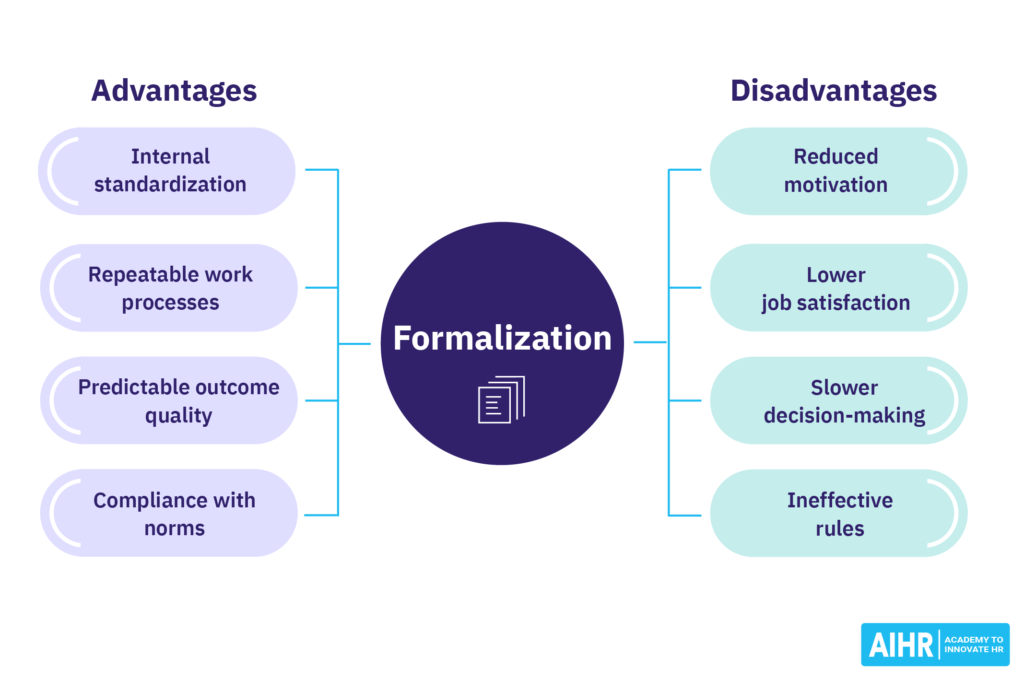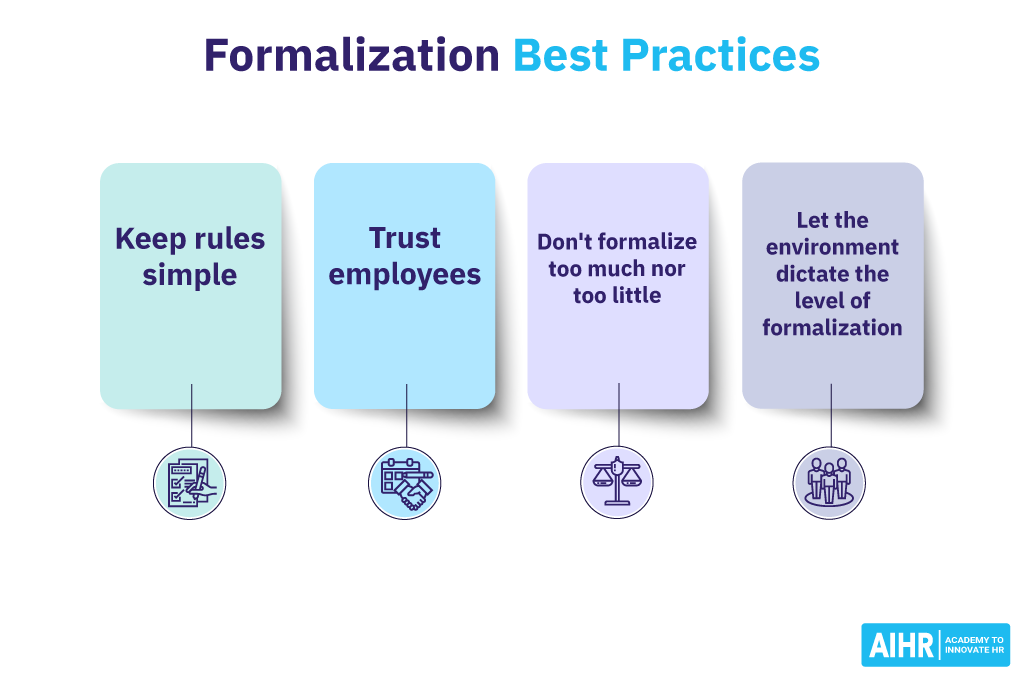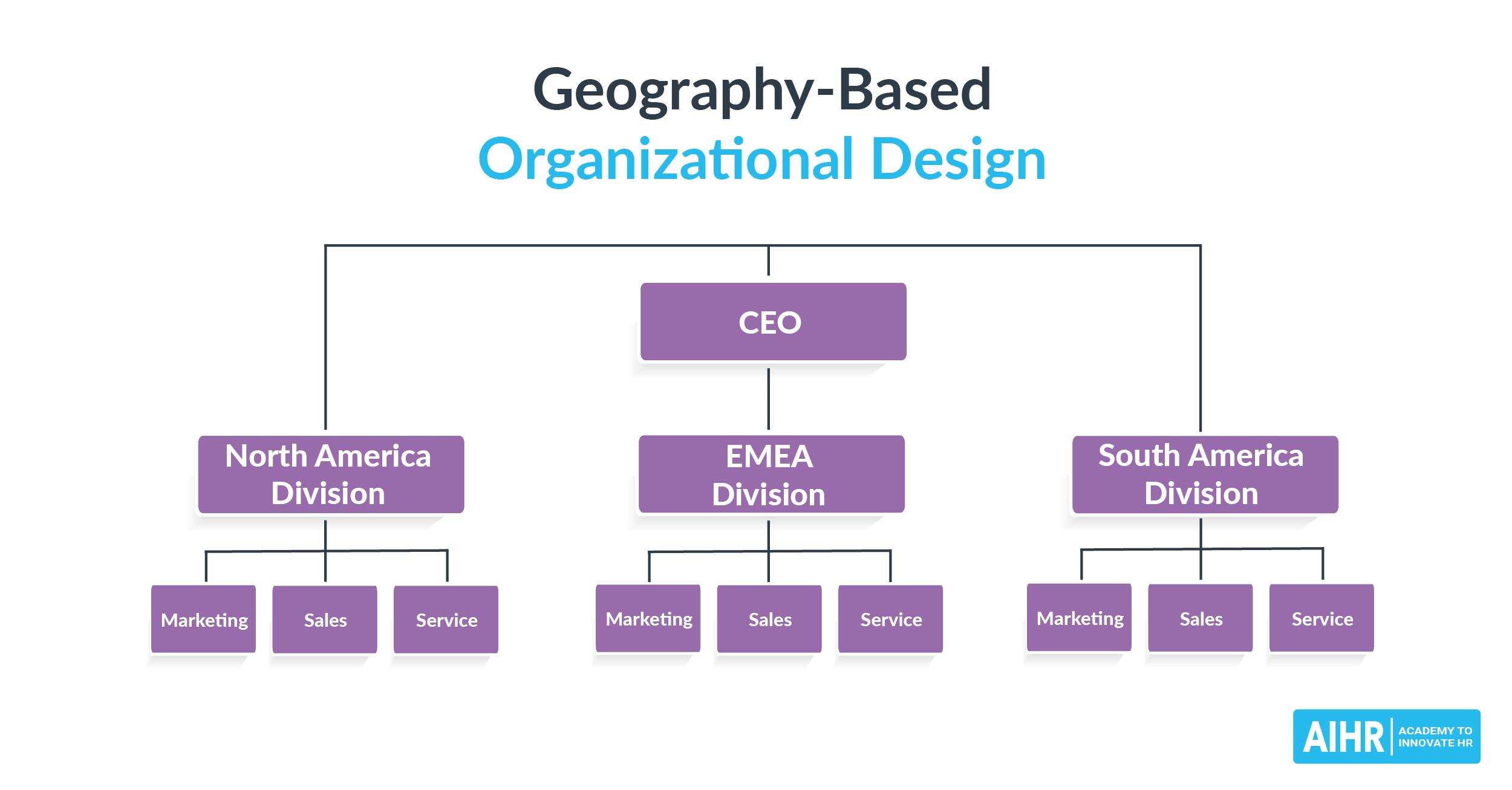Formalization
What is formalization in an organization?
Formalization in an organization is the degree to which fixed rules and procedures dictate how employees should behave. Formalization is one of the key dimensions in organizational design as it helps the organization provide a more predictable product or service.
Examples of formalization
Which restaurant do you expect to be more formalized: a family-owned street food restaurant or a Michelin star restaurant? The former may have a couple of hygiene rules dictated by the Food and Drug Authorities. However, the latter will have extensive rules on greeting customers, presenting the food, cleaning tables, and even presenting the bill.
Other examples of formalization include job descriptions, clearly defined responsibilities, behavioral norms like how to request days off, how to inform the manager when you fall ill, internal bookkeeping norms, and so on.
Advantages of formalization
Formalizing rules is attractive as it creates a lot of benefits for the organization.
- Internal standardization. Rules enable the creation of standards. A common safety standard is to hold the handrail when climbing a flight of stairs on an oil rig. With this rule, you’re less likely to die if you slip.
- Repeatable work processes. Formalization enables creating repeatable work processes. This means that two machine operators who never spoke with each other can do the exact same job without any inconsistencies in their output. This makes roles replaceable and removes risk from the organization.
- Predictable product or service quality. As a result of formalization, the products or services that are produced are of higher quality. A Michelin Star restaurant is able to create a consistently great experience because they follow the same procedure.
- Compliance with external norms. Some products need to comply with an external norm. All electric machines in Europe need to be able to handle between 220 and 240 Volt. Otherwise, they are not allowed to be sold. The same thing happens with accounting standards and labor regulations.
Each of these reasons boils down to consistency and control. Because of the rules, the employer or manager is able to get exactly what they are looking for simply because the rules are followed.
Disadvantages of formalization
Too much formalization also has drawbacks.
- Reduced motivation. Rules reduce the autonomy of the worker, leading to lower motivation. This also means that a highly formalized work environment is not for everyone.
- Less fun. Following rules is less fun than coming up with the answer yourself. An increase in formalization will lead to lower job satisfaction.
- Slow decision-making. Formalization reduces autonomy and standardizes decision-making processes. Decisions must first travel through the organizational hierarchy, slowing them down and making the organization less agile.
- Ineffective rules. Sometimes you can help a customer better by breaking a rule. Say a customer knocks on the shop door at closing time. The rule is to let no customers in after ten minutes before closing time, but you help them anyway. Technically, you’ve broken a rule, but the customer will be happy.

Formalization best practices
Implementing rules and processes works well, as long as organizations apply them sensibly. Here are four best practices for formalization.
- Create simple rules. If possible, keep the rules simple. Complex rules are harder to follow and thus less effective. Netflix’s expense policy is summarized in one sentence: “Act in the company’s best interest”. Based on that, everyone can use their own good judgement. This is a much more effective rule than a 10-page document about which expenses are and are not allowed.
- Onus on the employee. In line with the Netflix example: don’t overprescribe. Rules are a way to keep control but trust in people to use their best judgement is equally important. If you create rules because you don’t trust employees, you are not solving the right problem.
- Formalization is a balancing act. The degree of formalization is an inverted-U curve. Too little formalization will bring chaos. Being too structured will slow things down and ensure that nothing gets done. Always aim for an optimum structure, between too many and too few rules.
- Determine what level of formalization fits your environment. Optimum formalization depends on a number of factors. In her work, Professor Kathleen Eisenhardt mentions the following example factors:
- Uncertainty. When uncertainty in the market is high, you will want to stick to lower formalization because the market is likely to change and evolve, and rules will slow down decision-making. This is why large, established companies often don’t succeed in new markets. In low uncertainty markets, higher formalization will be beneficial as the market is predictable.
- Organizational newness. Emerging, small organizations often have very little formalization. The most successful small entrepreneurial organizations have more structure than their peers, enabling them to outperform their competitors. If this is your organization, keep on the side of structure.








